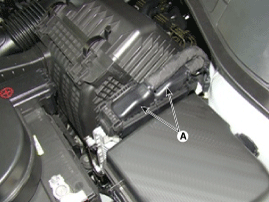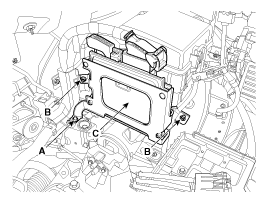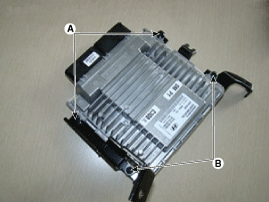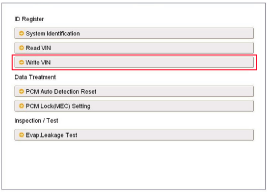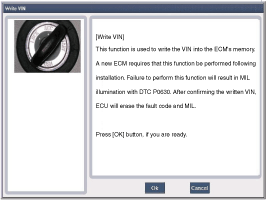 Hyundai Santa Fe: Engine Control Module (ECM). Repair procedures
Hyundai Santa Fe: Engine Control Module (ECM). Repair procedures
Removal
When replacing the ECM, the vehicle equipped with the immobilizer
must be performed procedure as below.
[In the case of installing used ECM]
1) Perform "ECM Neutral mode" procedure with GDS.
(Refer to Body Electrical System - "Immobilizer System")
2) After finishing "ECM Neutral mode", perform "Key teaching"
procedure with GDS.
(Refer to Body Electrical System - "Immobilizer System")
[In the case of installing new ECM]
Perform "Key teaching" procedure with GDS. (Refer to "Immobilizer"
in BE group)
|
When replacing the ECM, the vehicle equipped with the smart key
system (Button start) must be performed procedure as below.
[In the case of installing used ECM]
1) Perform "ECM Neutral mode" procedure with GDS.
(Refer to Body Electrical System - "Smart key System")
2) After finishing "ECM Neutral mode", insert the key (or press
the start button) and turn it to the IGN ON and OFF position. Then the
ECM learns the smart key information automatically.
[In the case of installing new ECM]
Insert the key (or press the start button) and turn it to the
IGN ON and OFF position. Then the ECM learns the smart key information
automatically.
|
| 1. |
Turn ignition switch OFF and disconnect the negative (-) battery
cable.
|
| 2. |
Disconnect the ECM Connector (A).
|
| 3. |
Remove the battery.
(Refer to Engine Electrical System - "Battery")
|
| 4. |
Remove the air cleaner assembly.
(Refer to Engine Mechanical System - "Air Cleaner")
|
| 5. |
Remove the mounting bolts (A) and nut (B), and then remove the
ECM (C).
|
| 6. |
After romoving the installation nuts (A) and screws (B), romove
the ECM (C) from the bracket.
|
Installation
When replacing the ECM, the vehicle equipped with the immobilizer
must be performed procedure as below.
[In the case of installing used ECM]
1) Perform "ECM Neutral mode" procedure with GDS.
(Refer to Body Electrical System - "Immobilizer System")
2) After finishing "ECM Neutral mode", perform "Key teaching"
procedure with GDS.
(Refer to Body Electrical System - "Immobilizer System")
[In the case of installing new ECM]
Perform "Key teaching" procedure with GDS. (Refer to "Immobilizer"
in BE group)
|
When replacing the ECM, the vehicle equipped with the smart key
system (Button start) must be performed procedure as below.
[In the case of installing used ECM]
1) Perform "ECM Neutral mode" procedure with GDS.
(Refer to Body Electrical System - "Smart key System")
2) After finishing "ECM Neutral mode", insert the key (or press
the start button) and turn it to the IGN ON and OFF position. Then the
ECM learns the smart key information automatically.
[In the case of installing new ECM]
Insert the key (or press the start button) and turn it to the
IGN ON and OFF position. Then the ECM learns the smart key information
automatically.
|
| 1. |
Install in the reverse order of removal.
|
ECM Problem Inspection Procedure
| 1. |
TEST ECM GROUND CIRCUIT: Measure resistance between ECM and chassis
ground using the backside of ECM harness connector as ECM side check
point. If the problem is found, repair it.
|
| 2. |
TEST ECM CONNECTOR: Disconnect the ECM connector and visually
check the ground terminals on ECM side and harness side for bent pins
or poor contact pressure. If the problem is found, repair it.
|
| 3. |
If problem is not found in Step 1 and 2, the ECM could be faulty.
If so, make sure there were no DTC's before swapping the ECM with a
new one, and then check the vehicle again. If DTC's were found, examine
this first before swapping ECM.
|
| 4. |
RE-TEST THE ORIGINAL ECM: Install the original ECM (may be broken)
into a known-good vehicle and check the vehicle. If the problem occurs
again, replace the original ECM with a new one. If problem does not
occur, this is intermittent problem (Refer to “Intermittent Problem
Inspection Procedure” in Basic Inspection Procedure).
|
VIN Programming Procedure
VIN (Vehicle Identification Number) is a number that has the vehicle's
information (Maker, Vehicle Type, Vehicle Line/Series, Body Type, Engine Type,
Transmission Type, Model Year, Plant Location and so forth. For more information,
please refer to the group "GI" in this SERVICE MANUAL). When replacing an ECM,
the VIN must be programmed in the ECM. If there is no VIN in ECM memory, the
fault code (DTC P0630) is set.
The programmed VIN cannot be changed. When writing the VIN, confirm
the VIN carefully
|
| 1. |
Select "VIN Writing" function in "Vehicle S/W Management".
|
| 2. |
Select "Write VIN" in "ID Register".
|
| 3. |
Input the VIN.
|
| 4. |
Turn the ignition switch OFF, then back ON.
|
 Engine Control Module (ECM). Schematic Diagrams
Engine Control Module (ECM). Schematic Diagrams
ECM Terminal And Input/Output signal ECM Terminal Function Connector [C100-A] Pin No. Description Connected to 1 Ignition Coil (Cylinder #2) control output [NON-smart key type] Ignition Coil (Cylinder ...
 ETC (Electronic Throttle Control) System. Description and Operation
ETC (Electronic Throttle Control) System. Description and Operation
Description The Electronic Throttle Control (ETC) System consists of a throttle body with an integrated control motor and throttle position sensor (TPS). Instead of the traditional throttle cable, an Accelerator ...
See also:
MTS Antenna. Components and Components
Location
Components ...
Repair procedures
On-vehicle Inspection Inspect ignition coil assembly and Perform spark test 1. Check for DTCs. • If a DTC is present, perform troubleshooting in accordance with the procedure for that DTC. (Refer to ...
Specifications
Tightening Torques Item N.m kgf.m lb-ft Passenger airbag(PAB) 7.8 ~ 11.8 0.8 ~ 1.2 5.8 ~ 8.7 Curtain airbag (CAB) Bolt 7.8 ~ 10.8 0.8 ~ 1.2 5.8 ~ 8.7 Nut 3.9 ~ 5.9 0.4 ~ 0.6 2.9 ~ 4.3 Knee airbag (KAB) ...

